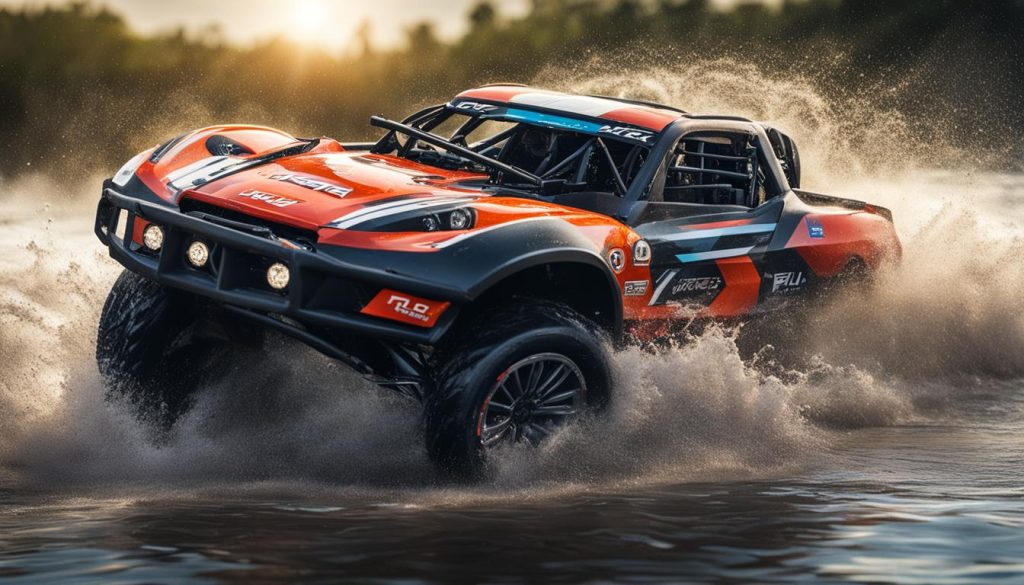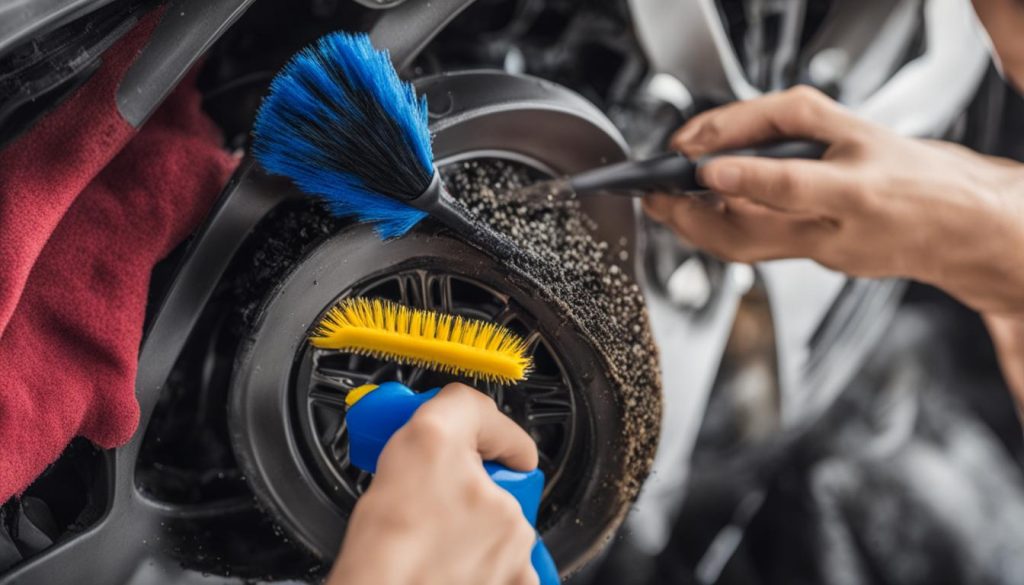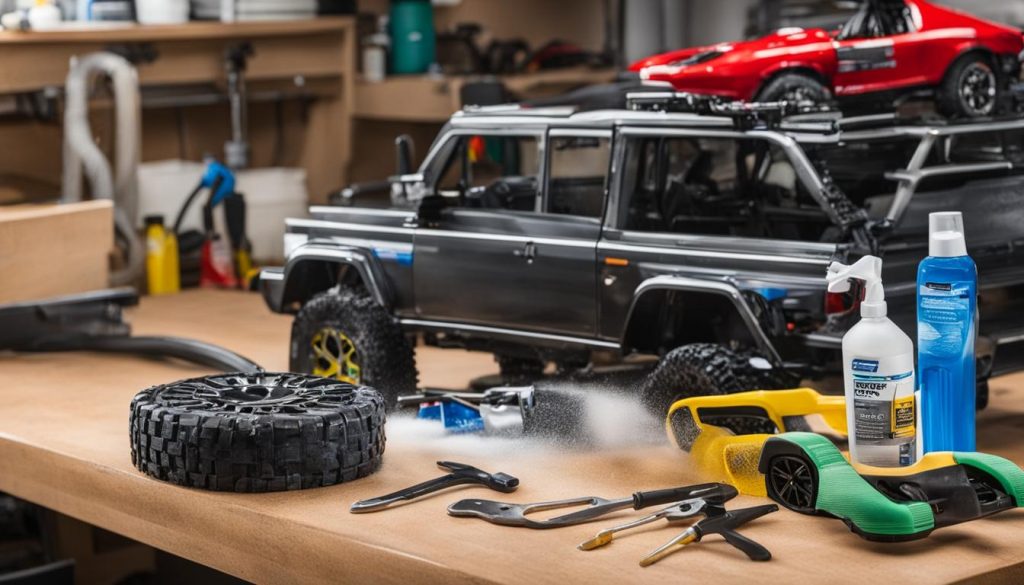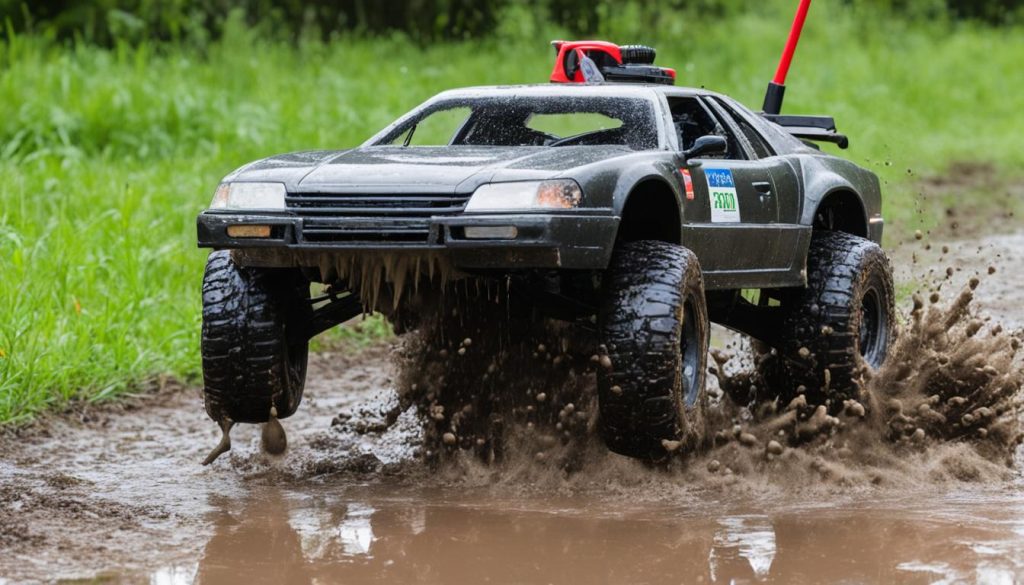RC cars are a popular hobby for many enthusiasts, providing hours of fun and excitement. But what happens when it starts to rain or you want to take your RC car for a spin near water? Can RC cars get wet, or are they strictly for dry land adventures?
Waterproofing refers to the ability of an RC car to handle getting wet and what happens afterwards. While RC cars labeled as “waterproof” can tolerate wet conditions to some extent, it’s important to understand their limitations. Driving the car fully submerged in water can cause damage and potentially ruin your favorite toy.
To determine the waterproofness of an RC car, several factors come into play. Industrial ratings, hardware quality, speed control and servos, batteries, and tires all play a role in how well an RC car can handle water exposure. By understanding these factors, you can make an informed decision about whether a particular RC car is suitable for wet conditions or requires additional waterproofing measures.
In this article, we’ll explore the factors that determine the waterproofness of RC cars, how to waterproof and protect your RC car, why water and RC cars don’t mix well, and the necessary steps for preparation and aftercare. By the end, you’ll have a clearer understanding of how to enjoy your RC car in wet conditions without risking water damage.
Key Takeaways:
- RC cars labeled as “waterproof” can handle wet conditions to some extent, but full submersion can cause damage.
- Factors that determine waterproofness include industrial ratings, hardware quality, speed control and servos, batteries, and tires.
- Proper waterproofing measures such as wrapping delicate parts and applying protective coatings can enhance an RC car’s ability to withstand water exposure.
- Water and RC cars don’t mix well due to the risks of electrical damage and component wear.
- Preparation, waterproofing, and aftercare are essential in minimizing the potential for water damage and ensuring the longevity of your waterproof RC car.
Factors that Determine Waterproof RC Car
When it comes to determining the waterproof capabilities of an RC car, several factors play a crucial role. These factors not only determine the car’s ability to withstand water exposure but also contribute to its overall performance in wet conditions. Understanding these factors can help you choose the right RC car for your needs.
Industrial Ratings and Waterproofness
One of the key factors to consider is the industrial rating of an RC car. Industrial ratings are indicated by an IPX number, which represents the level of protection against water. A higher IPX number indicates better protection. So, when choosing a waterproof RC car, look for a higher IPX rating to ensure greater resistance to water damage.
Hardware Quality and Corrosion Resistance
The hardware quality of an RC car also plays a vital role in determining its waterproofness. High-quality materials are less likely to corrode when exposed to water, ensuring the longevity of the car’s performance in wet conditions. So, pay attention to the materials used in the construction of the car to ensure durability and corrosion resistance.
Speed Control, Servos, and Water Damage
Speed control and servos are critical components of an RC car, and they need to be protected from water damage. Waterproof RC cars often have sealed speed control systems and servos to prevent water from entering and damaging these sensitive parts. This ensures that the car can continue to function properly even when exposed to wet conditions.
Batteries and Waterproofness
The type of batteries used in an RC car can also affect its waterproofness. Different types of batteries, such as LiPo and NiMH, have varying levels of water resistance. LiPo batteries, for example, are known for their better resistance to water. So, if you’re looking for a waterproof RC car, consider opting for one that uses LiPo batteries for enhanced water protection.
Tires and Traction in Wet Conditions
Tires are another important factor to consider when determining the waterproofness of an RC car. Tires with foam inserts, as opposed to compressed air, provide better traction and stability, especially in wet conditions. These tires offer improved control over wet surfaces, making them ideal for water-resistant RC cars.
By considering these factors, you can make an informed decision when choosing a waterproof RC car that meets your specific needs and delivers optimal performance in wet conditions.
How to Waterproof Your RC Car?
Protecting your RC car from water damage is essential for ensuring its longevity and performance in wet conditions. By following a few simple steps, you can effectively waterproof your RC car and enhance its resistance to water exposure.
1. Wrap Delicate Parts
Start by wrapping electrical tapes and balloons around delicate parts of your RC car, such as the receiver and wiring connections. This creates a protective barrier against water and prevents any potential damage to these sensitive components.
2. Apply Silicone Adhesive
Use silicone adhesive to seal bearing holes and servos. Apply a thin layer of silicone adhesive to these areas to reduce the effects of water exposure. This will help prevent water from seeping into the internal components and causing damage.
3. Add a Plastic Dip
To provide additional protection, consider adding a plastic dip around the engine area of your RC car. This creates a waterproof barrier and shields the engine from any potential water damage. Make sure to apply the plastic dip evenly and allow it to dry completely before using the RC car.
4. Regular Cleaning
After using your RC car in wet conditions, it is important to clean it thoroughly to remove any moisture or trapped dirt. Use a damp cloth or brush to gently clean the various parts of the car, including the chassis, tires, and electronic components. Proper cleaning helps maintain the car’s performance and prevents corrosion over time.
By following these steps, you can effectively waterproof your RC car and protect it from water damage. Taking the time to prepare and maintain your RC car for wet conditions will not only prolong its lifespan but also ensure optimal performance in any weather.
How to Protect Your Waterproof RC Car?
Once you have ensured that your RC car is waterproof, it’s crucial to know how to properly protect it when driving in wet conditions. By taking a few key steps, you can minimize the risk of water damage and maintain the performance and longevity of your waterproof RC car.
1. Test Materials for Compatibility
Before subjecting your RC car to water, it’s important to test any additional materials you plan to use for protection. This includes adhesives, tapes, or covers. By testing these materials for compatibility, you can ensure that they won’t react negatively with the electronics present in the car.
2. Check and Protect Crucial Parts
Prior to driving your RC car in water, it’s essential to carefully inspect and protect all crucial components. Make sure that sensitive areas such as the receiver, battery compartment, and servo connections are fully covered and protected from water exposure. This will help prevent any potential damage to these important parts.
3. Proper Cleaning After Use
After using your waterproof RC car in wet conditions, it’s important to thoroughly clean and dry it. This step helps remove any moisture and trapped dirt, reducing the risk of corrosion and potential damage to the electronic components. Pay special attention to areas that may take longer to dry, such as connectors and seams.
“Proper cleaning after use helps remove moisture and trapped dirt, reducing the risk of corrosion.”
By following these protective measures, you can significantly minimize the risk of water damage to your waterproof RC car. Taking extra care and maintaining your RC car will not only ensure its optimal performance but also extend its lifespan in wet conditions.
Why Water & RC Cars Don’t Mix
Water and electricity do not mix well, and the same applies to RC cars. When running an electric RC car in wet environments, proper precautions should be taken to avoid water damage.
Water can have detrimental effects on both the electrical and non-electrical components of an RC car. Excessive exposure to water can lead to corrosion, rust, and accelerated wear and tear, compromising the performance and lifespan of the car.
Even if an RC car is labeled as “waterproof” from an electrical standpoint, it does not guarantee complete protection against long-term water exposure. The seals and protective measures in place can deteriorate over time, allowing water to penetrate the car’s sensitive parts.
Understanding the potential risks of water damage is crucial for RC car enthusiasts. Water can cause various issues, such as:
- Short-circuits
- Malfunctioning electronics
- Corroded metal parts
- Rust on bearings and screws
- Sticky or locked-up gears
- Damaged insulation
It’s important to note that water damage may not be immediately apparent, but its effects can accumulate and lead to long-term problems. Therefore, it’s essential to take preventative measures to protect your RC car from water exposure.
“Water and electricity are not a safe combination, and RC car enthusiasts should take extra care when operating their vehicles in wet conditions.”
By implementing the following preventative measures, you can minimize the risk of water damage to your RC car:
- Waterproofing: Inspect your RC car’s waterproof seals and gaskets regularly. Replace any worn-out or damaged components to maintain its waterproof capabilities.
- Driving conditions: Avoid driving your RC car through deep puddles, standing water, or areas with intense splashing. These conditions increase the likelihood of water reaching your car’s critical components.
- Proper cleaning: After using your RC car in wet conditions, ensure thorough cleaning and drying. Pay particular attention to electronic components, bearings, and screws to remove any moisture.
- Storage: Store your RC car in a dry and moisture-free environment when not in use. Proper storage helps prevent the accumulation of moisture and minimizes the risk of water-related damage.
Remember: Taking these preventative measures can go a long way in protecting your RC car from water damage and ensuring its longevity and optimal performance.
Effects of Water on RC Cars
When water comes into contact with an RC car, whether through splashing or submersion, it can have the following effects:
| Effects of Water on RC Cars | Consequences |
|---|---|
| Short-circuits | Electrical components may malfunction or cease to function. |
| Corrosion and rust | Metal parts may corrode, leading to reduced performance and potential failure. |
| Ingress of dirt and debris | Water can carry dirt and debris into the RC car, damaging sensitive components and interfering with its operation. |
| Locked-up gears | Water can cause gears to become sticky or locked, preventing smooth movement. |
| Damage to insulation | Water can deteriorate the insulation on wires and connectors, compromising the electrical system’s integrity. |
Understanding the potential risks and effects of water on RC cars is essential for maintaining their longevity and performance. By taking precautions and implementing proper aftercare, you can enjoy the thrill of RC car racing without the worry of water-related damage.
Prepping Your RC for Water Exposure
Before exposing your RC car to water, it’s important to take certain preventative measures to increase its longevity and minimize the need for parts replacement. Even if your RC vehicle is not waterproof, you can still run it through shallow water as long as the water doesn’t touch any electrical components. Just remember to drive slowly to minimize splashing and spraying.
Understanding the waterproofing levels of your RC car is crucial in determining the suitable water exposure level. For example, some RC cars are designed for low-speed operation through water below the electronics. By knowing the capabilities of your RC car, you can ensure that you don’t subject it to unnecessary wear and tear.
If you’re preparing to take your RC car through water, consider these steps:
- Clean your RC car thoroughly to remove any dirt or debris that could interfere with its performance.
- Inspect the car for loose or damaged parts and make any necessary repairs or replacements.
- Seal any openings in the car’s body or chassis using waterproof tape or adhesive. This will help prevent water from seeping into sensitive areas.
- Apply a water-repellent spray to the car’s electronics to offer an additional layer of protection against water damage.
- Consider using a waterproofing solution, such as a conformal coating, on the electronic components of your RC car.
- Protect the tires by using tire foams or sealants to prevent water from entering and causing damage.
Remember, while these measures can help protect your RC car from water exposure, it’s still important to exercise caution when driving through water. It’s always better to err on the side of caution and avoid excessive water exposure whenever possible.
By taking these precautions and properly preparing your RC car, you can increase its durability and extend its lifespan, ultimately allowing you to enjoy your RC adventures even in wet conditions.
Preparing Your RC Car for Water Exposure
| Preventative Measures | Description |
|---|---|
| Clean thoroughly | Remove dirt and debris that may interfere with performance |
| Inspect for damage | Check for loose or damaged parts and make necessary repairs or replacements |
| Seal openings | Use waterproof tape or adhesive to prevent water from seeping into sensitive areas |
| Apply water-repellent spray | Add an extra layer of protection to the electronics |
| Consider waterproofing solutions | Use conformal coating for electronic components |
| Protect tires | Use tire foams or sealants to prevent water damage |
Waterproofing Level and Protection
The waterproofing level of an RC car determines its maximum tolerance for water exposure. Not all RC cars labeled as “waterproof” are capable of complete submersion. It is important to understand the limitations of different waterproofing levels to protect your RC car from water damage.
To ensure optimal protection, it is recommended to take additional preventative measures in addition to relying solely on the waterproofing level. These measures include:
- Covering vented tires to prevent water from seeping in.
- Lubricating the drivetrain to reduce friction and water damage.
- Treating batteries and motors with specific products to enhance their water resistance.
By implementing these steps, you can provide your RC car with extra protection and extend its lifespan when exposed to wet conditions.
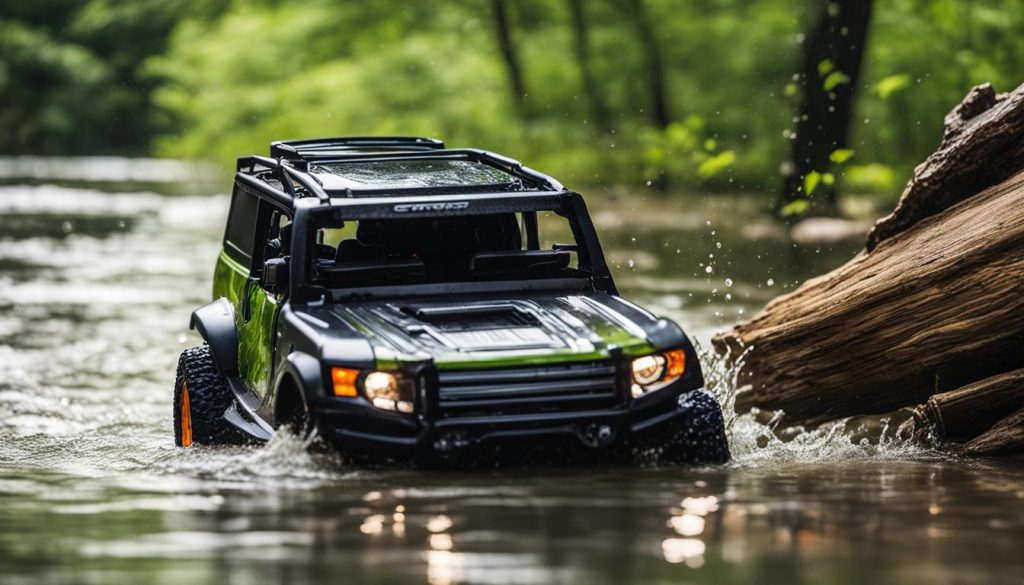
The Waterproofing Level and Protection Table
| Waterproofing Level | Maximum Water Exposure | Protective Measures |
|---|---|---|
| IPX4 | Light rain and splashes | Cover vented tires, lubricate drivetrain, treat batteries and motors |
| IPX5 | Heavy rain and puddles | Cover vented tires, lubricate drivetrain, treat batteries and motors |
| IPX7 | Temporary submersion in shallow water | Cover vented tires, lubricate drivetrain, treat batteries and motors |
| IPX8 | Extended submersion | Cover vented tires, lubricate drivetrain, treat batteries and motors |
Note: The table represents general guidelines. Always refer to the manufacturer’s specifications for the specific waterproofing level and protective measures recommended for your RC car model.
Waterproofing Your RC
Waterproofing an RC car is essential to protect it from water damage and ensure its longevity in wet conditions. By following specific steps and using the right materials, you can effectively waterproof the key components of your RC car.
Waterproofing Individual Components
When it comes to waterproofing your RC car, it’s important to focus on key components such as the servo, ESC (Electronic Speed Controller), and receiver. Waterproofing these components individually enhances their ability to withstand water exposure.
To waterproof the servo, apply marine grease to the servo output spline. This grease acts as a barrier, preventing water from seeping into the internal components of the servo. It’s recommended to use a marine-grade grease that is specifically designed to resist water and offer long-term protection.
Expert Tip: Applying marine grease to the servo output spline enhances its waterproof capabilities, allowing your RC car to handle water with ease.
For the ESC, one effective method is to use conformal coating. Apply a thin layer of conformal coating to the circuit board of the ESC. This coating creates a protective barrier, safeguarding the electronic components from water damage. It’s important to ensure thorough coverage of the circuit board for optimal protection.
When waterproofing the receiver, you can use a product like Plasti Dip. This rubberized coating creates a watertight seal around the receiver, preventing water from reaching the delicate electronic components inside. Applying multiple layers of Plasti Dip ensures complete coverage and enhanced waterproofing capabilities.
Optimal Waterproofing Techniques
When applying waterproofing measures to your RC car, it’s important to follow specific techniques for each component. Here’s a summary of the steps:
| Component | Waterproofing Technique |
|---|---|
| Servo | Apply marine grease to the servo output spline. |
| ESC | Use conformal coating on the circuit board. |
| Receiver | Coat with multiple layers of Plasti Dip. |
By following these waterproofing techniques and using the recommended materials, you can ensure that your RC car is fully protected from water damage.
Aftercare
After running your RC car through water, proper aftercare is essential for ensuring its longevity and maintaining its waterproof capabilities. Cleaning and drying the car thoroughly helps prevent damage and reduces the risk of corrosion. By following these aftercare steps, you can enjoy optimal performance from your waterproof RC car in wet conditions.
Cleaning After Water Exposure
After playing with your RC car in water, it’s important to clean it to remove any moisture and trapped dirt. Here are the steps to effectively clean your RC car:
- Start by rinsing the car with clean water to remove any visible dirt or debris.
- Use a mild detergent or RC car cleaner to scrub the body, tires, and other parts gently.
- Rinse the car thoroughly to ensure all soap or cleaner residue is removed.
- Inspect the car for any remaining dirt or grime and clean those areas with a soft brush or cloth.
Pay special attention to protective parts, such as the battery compartment and electronic components, as they may take longer to dry. Ensure all parts are completely dry before using or storing the RC car.
Maintenance and Protection
In addition to cleaning, regular maintenance is important for keeping your waterproof RC car in optimal condition. Here are some tips for maintenance and protection:
- Check the car’s tires regularly for wear and tear. Replace them if necessary to maintain good traction in wet conditions.
- Inspect the car’s battery and charging system for any signs of damage or malfunction. Replace or repair any faulty components.
- Lubricate the car’s moving parts, such as gears and bearings, to ensure smooth operation and prevent rust.
By following these maintenance and protection practices, you can prolong the lifespan of your waterproof RC car and enjoy many more exciting wet adventures.
| Aftercare Steps | Benefits |
|---|---|
| Clean the RC car after water exposure | Prevents damage and maintains waterproof capabilities |
| Thoroughly dry all parts | Reduces the risk of corrosion |
| Regularly inspect and maintain the car | Ensures optimal performance and prolongs lifespan |
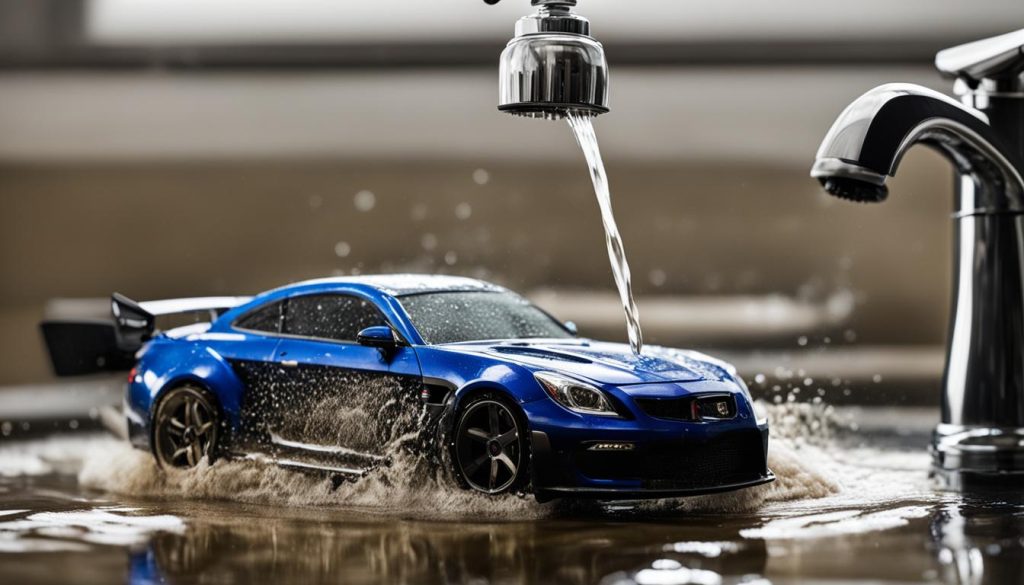
“Proper aftercare can greatly extend the lifespan of your waterproof RC car and ensure its optimal performance in wet conditions.”
Refund Policy
In the unfortunate event that you receive a damaged RC car or encounter a defect, it’s important to understand EuroRC’s refund and warranty policies. We strive to provide excellent customer service and address any issues promptly.
“At EuroRC, our goal is to ensure your satisfaction with your RC car purchase. We offer a refund policy for new, unused merchandise within 14 days of delivery.”
To initiate a return, simply contact our customer service team via email, and they will guide you through the process. It’s crucial to initiate the return within the specified timeframe for eligibility.
The refund process typically takes 1-3 business days once the returned merchandise has been inspected and verified to be in resellable condition. We want to ensure that you receive your refund as quickly as possible.
“We also provide assistance for defective parts within the warranty period, which varies depending on the manufacturer.”
If you encounter any issues with the RC car parts within the warranty period, reach out to our customer service team for guidance on returning or replacing defective components. Our knowledgeable staff will assist you and ensure that you have a positive experience with EuroRC.
For specific details regarding our refund and warranty policies, please contact our customer service team. They will be happy to provide you with the necessary information and answer any questions you may have.
| Refund Policy | Warranty |
|---|---|
| New, unused merchandise within 14 days of delivery | Assistance for defective parts within the warranty period |
| Contact customer service via email to initiate a return | Contact customer service for guidance on returning or replacing defective components |
| Refund process takes 1-3 business days | Warranty period varies depending on the manufacturer |
What happens if EuroRC made an error in the shipment?
In the rare occurrence of an error in the shipment from EuroRC, you are advised to contact EuroRC immediately to rectify the situation. EuroRC aims to minimize errors, but they understand that mistakes can happen. By promptly notifying EuroRC of any shipment errors, they can make it right and provide the necessary assistance to resolve the issue and ensure your satisfaction.
Conclusion
After exploring the topic of waterproofing RC cars, it is clear that while these vehicles can handle wet conditions to some extent, they have their limitations. Although RC cars labeled as “waterproof” can withstand exposure to water, it’s important to note that full submersion can still result in damage. To make an informed decision when choosing an RC car for wet conditions, understanding the factors that determine waterproofness, such as industrial ratings, hardware quality, and component sealing, is crucial.
In addition to choosing the right model, taking steps to waterproof and protect your RC car can enhance its durability in water. Measures like wrapping delicate parts, applying silicone adhesive, and adding a plastic dip can provide an extra layer of protection. It’s also essential to clean your RC car regularly to prevent corrosion and maintain its performance.
However, it’s worth emphasizing that water and RC cars do not mix well due to the risks of electrical damage and component wear. While waterproofing efforts can help minimize water damage, proper preparation, waterproofing, and aftercare are necessary to protect your RC car. By following these precautions, you can help prolong the lifespan of your waterproof RC car and minimize the potential for water-related issues.
In conclusion, while it is possible to waterproof RC cars to a certain extent, it is important to understand the limitations. Choose the right model, take appropriate waterproofing measures, and ensure proper aftercare to enjoy your RC car in wet conditions while minimizing the risk of water damage.
FAQ
Can RC cars get wet?
While RC cars with a waterproof stamp can handle wet conditions to some extent, driving them fully submerged in water can cause damage.
What factors determine the waterproofness of an RC car?
Industrial ratings, hardware quality, speed control and servos, batteries, and tires all contribute to the waterproof capabilities of an RC car.
How can I waterproof my RC car?
Wrapping electrical tapes and balloons, applying silicone adhesive, and adding a plastic dip are some steps you can take to waterproof your RC car.
How can I protect my waterproof RC car?
Testing materials for compatibility, checking and covering crucial parts, and regularly cleaning the car can help protect it from water damage.
Why don’t water and RC cars mix well?
Water can damage electrical and non-electrical components of an RC car, causing parts to wear out faster and potentially leading to rust.
How can I prep my RC car for water exposure?
Running non-waterproof RC cars through shallow water is possible as long as the water doesn’t touch any electrical components. Drive slowly to minimize splashing and spraying.
What is the waterproofing level of an RC car?
The waterproofing level determines the maximum water exposure an RC car can handle. Not all “waterproof” RC cars are suitable for complete submersion in water. Understanding the limitations is important.
How can I waterproof my RC car?
Components such as the servo, ESC, and receiver can be waterproofed individually by applying marine grease and Plasti Dip.
How should I care for my waterproof RC car after running it in water?
Clean and dry the car thoroughly to remove moisture and trapped dirt, reducing the risk of corrosion and maintaining its waterproof capabilities.
What is the refund policy for RC cars from EuroRC?
EuroRC offers a refund for new, unused merchandise within 14 days of delivery. Contact EuroRC via email to initiate a return.
What happens if EuroRC made an error in the shipment?
If a shipping error occurs, customers are advised to contact EuroRC immediately for assistance in rectifying the situation.

